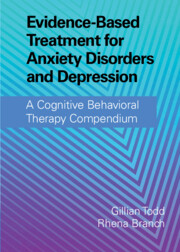 Evidence-Based Treatment for Anxiety Disorders and Depression
Evidence-Based Treatment for Anxiety Disorders and Depression Book contents
- Evidence-Based Treatment for Anxiety Disorders and Depression
- Evidence-Based Treatment for Anxiety Disorders and Depression
- Copyright page
- Contents
- Figures
- Tables
- Contributors
- 1 Introduction
- 2 The History and Philosophical Underpinnings of CBT:
- Part One Cognitive Behavioral Therapy for Anxiety Disorders
- 3 CBT for Specific Phobias
- 4 CBT for Panic Disorder
- 5 The Cognitive Behavioral Treatment of Agoraphobia
- 6 Cognitive Behavioral Therapy for Social Anxiety Disorder
- 7 CBT for Social Anxiety Disorder
- 8 CBT for Somatic Symptom Disorder and Illness Anxiety Disorder
- 9 Cognitive Behavioral Therapy for Generalized Anxiety Disorder:
- Part Two Cognitive Behavioral Therapy for Posttraumatic Stress Disorder
- Part Three Cognitive Behavioral Therapy for Obsessive-Compulsive Disorder and Associated Disorders
- Part Four Cognitive Behavioral Therapy for Depression
- Part Five Complexity and Comorbidity in Anxiety Disorders and Depression:
- Part Six Specialist Applications of Cognitive Behavioral Therapy for Anxiety Disorders and Depression
- Part Seven Future Developments
- Appendices
- Index
- References
3 - CBT for Specific Phobias
from Part One - Cognitive Behavioral Therapy for Anxiety Disorders
Published online by Cambridge University Press: 06 January 2022
- Evidence-Based Treatment for Anxiety Disorders and Depression
- Evidence-Based Treatment for Anxiety Disorders and Depression
- Copyright page
- Contents
- Figures
- Tables
- Contributors
- 1 Introduction
- 2 The History and Philosophical Underpinnings of CBT:
- Part One Cognitive Behavioral Therapy for Anxiety Disorders
- 3 CBT for Specific Phobias
- 4 CBT for Panic Disorder
- 5 The Cognitive Behavioral Treatment of Agoraphobia
- 6 Cognitive Behavioral Therapy for Social Anxiety Disorder
- 7 CBT for Social Anxiety Disorder
- 8 CBT for Somatic Symptom Disorder and Illness Anxiety Disorder
- 9 Cognitive Behavioral Therapy for Generalized Anxiety Disorder:
- Part Two Cognitive Behavioral Therapy for Posttraumatic Stress Disorder
- Part Three Cognitive Behavioral Therapy for Obsessive-Compulsive Disorder and Associated Disorders
- Part Four Cognitive Behavioral Therapy for Depression
- Part Five Complexity and Comorbidity in Anxiety Disorders and Depression:
- Part Six Specialist Applications of Cognitive Behavioral Therapy for Anxiety Disorders and Depression
- Part Seven Future Developments
- Appendices
- Index
- References
Summary
Although fear can protect us from harm and prepare us for danger, disproportionately extreme fear can turn into a specific phobia when it leads to extreme avoidance of and distress in feared situations, thereby interfering with our lives and mental well-being. This chapter gives instructions and examples of how an assessment and mini formulation for specific phobias can help to construct a ‘fear hierarchy’ and to understand which ‘safety behaviors’ can maintain phobias. With case illustrations, the chapter describes how to apply exposure therapy, the cornerstone CBT method for specific phobias, in which an individual gradually confronts each trigger in the fear hierarchy while refraining from safety behaviors. The chapter also outlines how to overcome common difficulties with exposure therapy and how to measure therapy outcomes. Finally, cognitive restructuring is discussed as a CBT approach for specific phobias in which exposure-based activities are used to test and challenge exaggerated or unhelpful ideas about feared situations.
- Type
- Chapter
- Information
- Evidence-Based Treatment for Anxiety Disorders and DepressionA Cognitive Behavioral Therapy Compendium, pp. 29 - 49Publisher: Cambridge University PressPrint publication year: 2022
References
Further Recommended Reading
This is the definitive guide on CBT for specific phobias. The first part of
the book gives an extensive background on the phenomenology and
assessment of specific phobias; it also gives an overview of the evidence
for various treatments for specific phobias. The second part of the book
focuses on one-session treatment for specific phobias with adults and
children. It gives detailed instructions and treatment plans and materials
on how to conduct one-session treatments. The last part of the book
addresses special topics in CBT for specific phobias, including how to
train therapists and assess their competence, how to adapt the treatment
for specialist populations (e.g., people with learning or developmental
difficulties), ethical issues, research evidence, and use of technologies.


